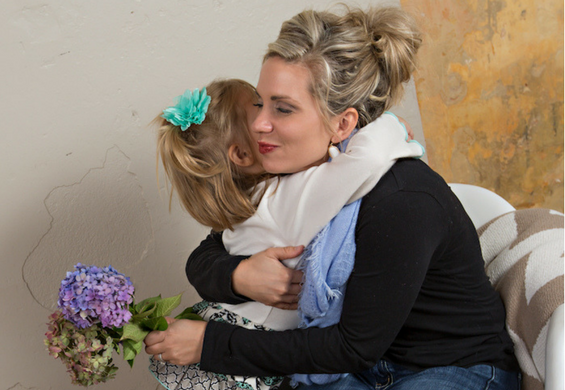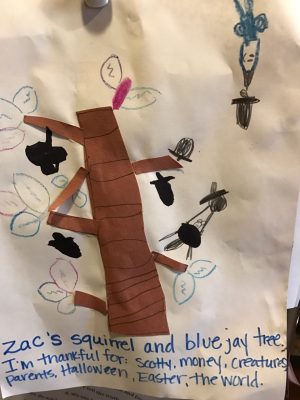
15 Nov 12 tips to teach gratitude to a preschooler
When your child’s favorite phrases are “that’s mine” and “I want that,” you’re probably wondering how to teach gratitude to a preschooler. It’s perfectly normal for your preschooler to show stubbornness, of course. But sometimes you might wonder if she thinks the entire world revolves around her!
So how can you teach gratitude to a preschooler? First, let’s consider how gratitude can actually help your child.
The importance of an attitude of gratitude
Recent studies have shown the power of an attitude of gratitude. Here are just a few:
- Gratitude improves your physical health.
Robert A. Emmons, professor of psychology at UC Davis (@robertemmons42), conducted numerous studies on gratitude and how it affects people’s health. He found that having a grateful outlook can strengthen your immune system, help you sleep better, and even lower your blood pressure.
Other studies continue to show big health benefits of practicing thankfulness. One study at the University of California San Diego’s School of Medicine showed that people who are more grateful have healthier hearts. In the study, people with grateful hearts actually showed less inflammation and better heart rhythms. And, patients with congestive heart failure actually improved their heart health by keeping a daily gratitude journal.
- Gratitude improves your mental health.
In several studies led by Emmons, people who practice gratitude feel more joyful and optimistic. In fact, the studies showed that practicing gratitude can increase your level of happiness by about 25 percent. Emmons explains that feelings of thankfulness and appreciation block other negative feelings such as envy, resentment, and regret. And, one study led by psychologist Alex Wood shows that practicing gratitude can actually reduce stress levels and help prevent depression.
- Gratitude grows your EQ—your emotional IQ.
Early education experts agree that emotional intelligence is just as important as academic knowledge. This is why social-emotional skills, such as sharing, empathy, and kindness, are taught alongside other kindergarten readiness skills in the Dilly’s Tree House family engagement program. An attitude of thankfulness naturally incorporates these important social-emotional skills, according to the Yale Center for Emotional Intelligence (@YaleEmotion).
Gratitude also leads to less aggression, according to a 2011 study at the University of Kentucky. This is because of gratitude’s link with empathy. People who are able to empathize with others naturally show less aggression. For ideas on how to teach your child empathy, check out our post on empathy.
- Gratitude helps build relationships.
People who practice gratitude are considered by others to be more helpful, trustworthy, and optimistic, according to the Yale Center for Emotional Intelligence. Gratitude also inspires people to perform acts of kindness and to “pass it on.” This outlook—and the positive behaviors associated with it—naturally builds and strengthens relationships.
Can my preschooler really learn to have an attitude of gratitude?
Absolutely! Consider this quote from tiny Piglet in the classic Winnie the Pooh stories by A. A. Milne:
“Piglet noticed that even though he had a Very Small Heart, it could hold a rather large amount of Gratitude.”
Keep in mind that teaching gratitude to children takes time, patience, and—yes—a grateful heart in YOU. It’s an ongoing process and it certainly won’t happen overnight. And, you’ll need to continue modeling and practicing thankfulness and appreciation throughout your child’s development. To get you started, here are some tips on how to teach gratitude to a preschooler.
12 tips on how to teach gratitude to a preschooler
- Model your own gratitude.
This is probably the most important tip, which is why we’ve listed it first. Your child learns by watching you and others around her. So, show gratitude every day. Show appreciation for the people who help you at home, at stores, or at work. Say thank you to the grocery store clerk, the delivery person, your spouse or significant other. Say thank you to your child when she does something you appreciate. Talk about being thankful and grateful for things, actions, and people in everyday conversations with your child—and in front of your child. Tell your child why you’re thankful for her, too!
- Count your blessings—every day.
Set aside some time for gratitude. Choose one time a day—whether it’s mealtime, bedtime, or even bath time—to talk about things you’re thankful for.
 Natalie Carter says she and her 7-year-old daughter, Austen, discuss what she calls her Pit and Peak every night before bedtime. Her Pit is the worst part of the day, while her Peak is the best part. “This leads into some great conversations,” says Natalie. And, she adds, it seems to foster a positive attitude. Austen often looks for ways to turn her negatives into positives, her mom says. “Sometimes her Pit is when kids are mean to other kids at school,” says Natalie. “We talk about how she can turn the situation around.”
Natalie Carter says she and her 7-year-old daughter, Austen, discuss what she calls her Pit and Peak every night before bedtime. Her Pit is the worst part of the day, while her Peak is the best part. “This leads into some great conversations,” says Natalie. And, she adds, it seems to foster a positive attitude. Austen often looks for ways to turn her negatives into positives, her mom says. “Sometimes her Pit is when kids are mean to other kids at school,” says Natalie. “We talk about how she can turn the situation around.”
If you need some inspiration, the holiday season is the perfect time to begin a gratitude project. Take a pumpkin or gourd—whether leftover from Halloween or a new one for Thanksgiving—and help your child write her blessings on it each day with a permanent marker. Or create a paper tree trunk and tape it on a wall. Help your child write something she’s thankful for each day on a paper leaf and add it to the tree trunk. Then continue the practice after the holidays by talking about daily thankfulness at bedtime or dinner.
- Let your child help.
Give your child chores to do! When he sees the work that goes into daily living, then he can better understand why gratitude is important. Many preschoolers can:
- Set and clear the table.
- Dust the furniture.
- Feed pets.
- Pick up toys.
- Help to cook meals.
- Carry in some groceries.
- Mop areas with help.
- Take laundry to the laundry room.
Be sure and show your appreciation when your child completes his chores, too.
- Teach your child to say thank you—and to mean it.
When your child receives a gift or act of kindness, talk with her about how it makes her feel. Connect the gift or action to the feeling of happiness or joy she feels when receiving it. Then, have her express this feeling to the giver with a “thank you.” You can have her draw a picture to thank the person. Or, help her write a short thank you note. You can also have her dictate the note to you.
What if your child isn’t particularly happy with a gift? It’s difficult to teach your child appreciation when she doesn’t truly enjoy a gift. The key is to prepare for this moment ahead of time. Before gift-giving occasions, explain that not saying “thank you” might make the giver sad. This helps her understand the connection between behavior and feelings. Also, talk with your child about the effort that goes into choosing gifts. If you can tell that your child isn’t happy with a gift or action, then gently prompt her. For example, say, “What a thoughtful thing to give! I can tell that a lot of effort went into choosing that gift, can’t you?”
- Resist the urge to give him everything he wants, all the time.
It’s tempting to give your child all the things that you wanted as a child. But keep in mind that this only creates a sense of entitlement in your child. Soon, he’ll begin to expect the newest toy or game. Saying “no” to a request teaches your child appreciation for the times you say “yes.”
- Make your child wait for something she wants.
When your child wants a particular toy—especially if it’s a large or expensive one—let her wait for it. Sometimes the anticipation of receiving a long-awaited item makes the moment of receiving it even more fun and exciting. And it teaches her to be patient and appreciate the item more.
- Avoid the comparison trap.
As humans, we naturally compare ourselves (and our children, homes, belongings) to others. But beware of doing this in front of your child. Pay attention to your thoughts and words every day, especially those -er words like better, nicer, bigger, and prettier. If you find yourself making a comparison (“Her car is much nicer than my car”), then catch yourself before you say it in front of your child.
Keep in mind that by making comparisons, you’re teaching your child to compare himself to others, too. And, as Theodore Roosevelt is quoted as saying, “Comparison is the thief of joy.” Spiritual studies abound on the dangers of comparison, like The Comparison Trap by Sandra Stanley. But you don’t have to be religious to recognize that comparison can cause you to be envious—the opposite of gratitude.
- Do projects to teach your child appreciation for community helpers.
Enlist your child’s help in projects to show appreciation for community workers and helpers. Here are some ideas:
- Bake and take cookies to local firefighters or police officers.
- Greet postal workers as they deliver letters and packages and say “thank you.”
- Have your child notice what his preschool teacher (or any other adult who helps him) likes most. It might be coffee from a certain coffee shop, flowers, art, or books. Then take your child to get a small token of appreciation—or make one—related to the helper’s favorite things.
- Help your child give to others.
When your child learns to give her time and energy to others, she is less likely to take things for granted (like her own family, health, and home). Here are some ideas:
- Make gift-giving a daily activity. In one of our many social-emotional activities in Dilly’s Tree House at-home learning system, children create a Gift Ideas Jar and add ideas for gifts to it. Daily gifts include hugs, kisses, smiles, jokes, nice notes, acts of kindness, and drawings. Each day, your child chooses a gift idea from the jar and surprises a family member or friend.
- Discuss a neighbor or friend who might need a little encouragement or help. Then take them a simple gift. An encouraging gift can be as simple as a clipped rose from a rose bush taken to an older neighbor. Or it can be a plate of cookies that you’ve baked together.
- If you have leftovers from a large meal, share the bounty! Let your child help you take the extra food to an older neighbor or friend who might appreciate a meal for one.
- Help your child choose old clothes or other items to take to local service organizations. Make sure she goes with you to deliver them.
- Point out the simple pleasures in life.
The ability to enjoy each moment leads to a grateful heart. Teach your child appreciation for life’s simple pleasures, such as a gentle rain, a star-filled night sky, a multitude of fireflies at dusk, and a glorious sunset. Point out these wonders and marvel at them in front of your child. You can also show appreciation for a delicious meal, music, and peaceful moments with your child.
- Role-play saying thank you and showing appreciation and thankfulness.
Young children learn through play with a purpose. Use dolls, action figures, or even puppets like the ones in Dilly’s Tree House to role-play different scenarios. For example, you can role-play giving and receiving a gift and saying “thank you.” You can role-play showing appreciation for a community helper—even a fictional one (“Thank you so much, Batman, for rescuing me!”).
- Read books about gratitude and thankfulness.
Read your child books that feature characters expressing gratitude. Read him books that lead to discussions about gratitude. Here are some of our recommendations:
The last book in the popular Elephant and Piggie series, this book follows Piggie as she goes on a “Thank-o-rama”—thanking everyone she knows.
Readers follow a family through the simple pleasures of one summer day—from a morning on the beach to a quiet night at home.
This award-winning book follows a boy and his grandma through a busy bus ride across town. Discussions between the boy and his grandma show children how to be thankful and giving to others.
Bear wants to hold a feast to thank his friends, but he has nothing in his cupboards to share!
In this book in the popular Little Critter series, a new kid has everything Little Critter wants. But Little Critter learns that he has something to really be thankful for—a family who loves him.
Jeremy wants the shoes that everyone else is wearing at school. But he soon learns that someone else needs them more than he does.
We love this video about gratitude for the simple things, from Story of This Life, so much, that we simply have to share it with you:
Do you have some additional tips for teaching gratitude to a preschooler? If so, please share them in the Comments section below.

Sorry, the comment form is closed at this time.